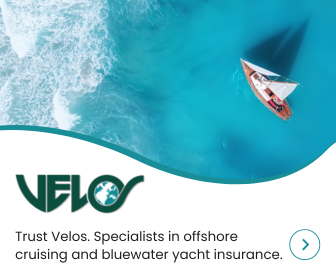Madagascar Part II: In Search of Chameleons and Lemurs
After dealing with the officialdom of checking into Madagascar and the numerous fees and paperwork demanded by officials, SV Pazzo and her crew were then free to continue their Madagascar adventure and set off in search of wildlife.
Published 12 months ago
Noonsite Note: The cruiser who provided this information wished to remain anonymous. This report from Madagascar reflects their experience – “the next cruiser may find something totally different”, said the author.
The Adventure Continues…
In our first report, we killed you with the minutia of entering foreign countries by yacht and our experience entering Madagascar in particular. With that behind us, let the adventure continue…
Once we were finally cleared into Madagascar with most of the officials satisfied that they’d squeezed from us what they could (a few continued to ask for “favors”), we booked a tour to Korma Island to visit the black lemur colony and search for photogenic birds. A lemur is a monkey-esque mammal with great climbing and jumping skills and an appetite for fruits and leaves.
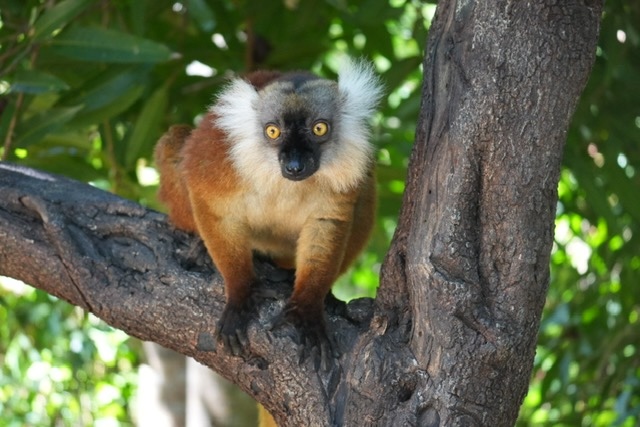

During our visit in Madagascar, we found five or six different types of lemurs (Maki in Malagasy), each distinctively colored but similarly behaved. They make a variety of sounds when high in the branches: quacking like a duck, guttural growls, and even screeches when feeling threatened. Cute? Oh yes! and with many human-like expressions and postures.
After another day in Hellville – offering moral support to the Hill family on Catamaran Atlas who were confined to their boat while the inept authorities tried to sort out their paperwork – we topped up our diesel (jerry jugs from the local Shell station) and headed out to Nosy Sakatia, a small island off the west coast of Nosy Be.
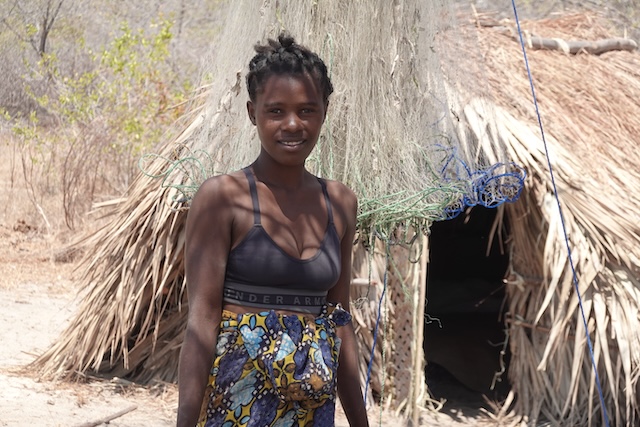

On Sakatia we found more common black Lemurs (female is brown), enjoyed a stunning hike across the island and a wonderful and affordable bar ($2.50/small cocktail) where Cindy could savor a mojito or two. Sakatia is also known for it’s population of large (huge?) sea turtles grazing on the sea-grass in the shallows near the anchorage.
Plenty of Anchorages and Islands to Explore
Crater Bay, about 5 miles from Hellville, is the home of “La Marina” which is little more than an over-sized dinghy dock and a large collection of moorings occupied by “neverleavers” and a few visiting cruisers. It’s a fairly well-protected anchorage on the south shore of Nosy Be where the dinghy is safe ashore and upscale resorts, restaurants and a decent public market are within walking distance.
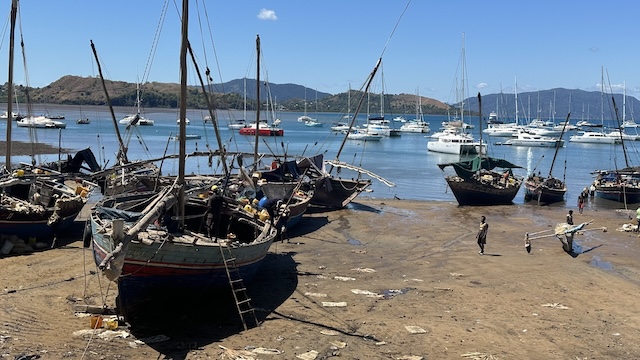

A couple of good supermarkets offer most of what we need (or prefer, really). Of note, alcohol is inexpensive. Wines from South Africa can be had for $10USD (swill for $5) and the good rum is $6-8/liter. Yes, we’re well stocked.
North and south from Nosy Be, lovely anchorages with gorgeous beaches, nice hiking trails, lemurs, chameleons and birds can be found. We ventured south to Russian Bay and Nosy Mamoko where we found friendly villagers and delivered gifts from stores. The matriarch of Mamoko welcomed us to her island after charging $1.50 each for taking photos in her village.
With her prominent gold incisors, she took talking with a full mouth to a whole new level. As she was arranging Leo, a charming young man to lead us on a bushwhacking tour of the island, she broadcast what looked like soggy cracker crumbs like a hand-crank seed spreader seeding a new lawn.
From the south, we reversed course to visit Nosy Mitsio, another beautiful island with an excellent anchorage, about 35 miles north of Nosy Be. We were joined in Mitsio by the Hill family on Atlas (Canadian), Champagne with Robert and Johanna (Swedish) and the Granath family on Ayla (also Swedish). While enjoying happy hour on Atlas, a large, overpowered open console speed boat approached to within hailing distance.
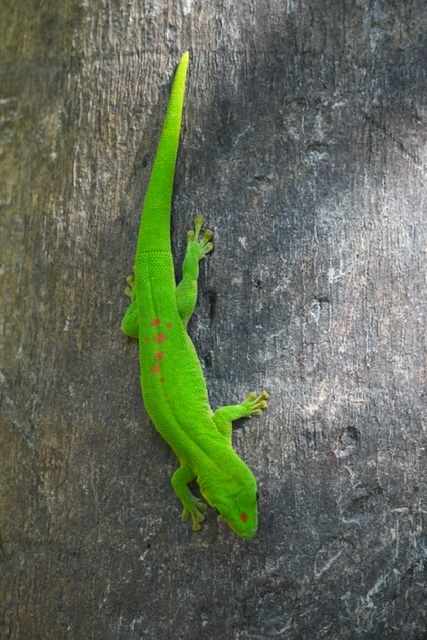

“Would you folks please stay clear of that small Island over there (pointing North), Nosy Ankarea, for the next few days? We’re filming there. Cheers for your cooperation,” he called with his notable British accent.
“What are you filming?” Brian queried. “Sorry, top secret” came the reply. It didn’t take long for the sleuths in our small fleet to break the secret. They were filming the last few days of Survivor-UK. I thought it would be big fun to dinghy straight over, march into “camp” and ask “Wazzup?”
Amazing Wildlife
We found some nice hikes and spent several unsuccessful hours hunting chameleons. I’m pretty sure those suckers dominate in hide-and-seek! In order to spot a chameleon, you need to be looking in precisely the right direction with precisely the right focal distance – and even then you might miss them blending in. They are generally motionless so you can’t look for movement.
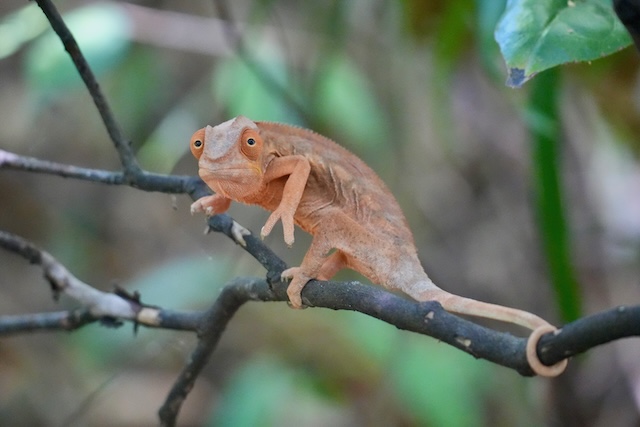

After Mitsio, we returned to Nosy Be and the Lokobe National Park where we found a local guide (calls himself “Indiana Jones – IJ”) to take us on a wildlife tour. IJ knows just where to find several types of chameleons, several types of lemurs, tiny frogs (world’s smallest), a huge boa constrictor and a few lizards that look like tree bark, blending in so well that it’s hard to believe they aren’t part of the tree! Amazing wildlife!
The Business of Clearing Out
From Mitsio, we returned to Hellville to prepare for our passage to South Africa, down the notorious Mozambique Channel. The business of clearing out of a country is the same as clearing in. Lots of photocopies of passports, ships documents, inward clearance documents, and in this case, “L’authorization de sortie” (Permission to leave). It’s hard to imagine why Madagascar’s Ministers would bother with such bunk, but maybe this is how they keep bureaucrats employed?
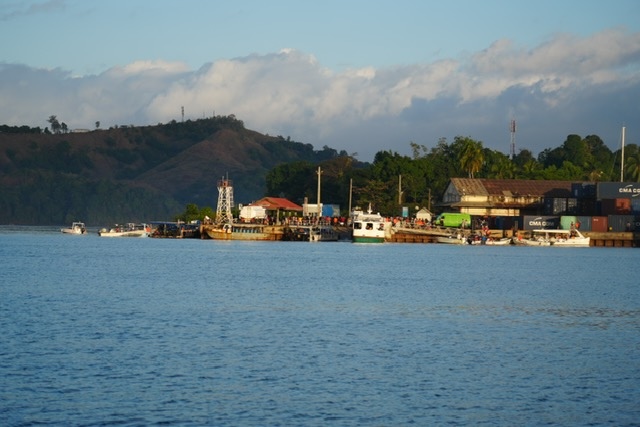

Certainly, immigration cares who comes and who goes and the same for customs regarding the yachts. But, my Lord, what a bunch of rubbish! And, of course, each official needs his outward clearance fee (120,000 ariary / $26USD) for the service of issuing outward clearance papers, or in some cases, just receipts.
Outward clearance can be conducted at any recognized port of entry/departure. Along Madagascar’s west coast there are three such ports: Hellville, Mahajanga (further down the NW coast) and Tulear (down near the south end of the island).
In years past, yachties have reported serious corruption and excessive fees charged by officials in Mahajanga and Tulear. Most yachts choose to clear out of Hellville as it’s easy and the corruption is light. Technically, once cleared out by the various officials, yachts are given a day or so to actually set sail for a foreign port. This rule seems rather flexible in Madagascar. Most yachts take a few days or weeks to sail south toward Cap St. Andre (western-most point of Madagascar), watching the weather for a good opportunity to cross the Mozambique channel.
So, on September 11, after topping up diesel, fresh fruits and vegetables, and samosas, we weighed anchor from Nosy Be to explore the southern two-thirds of Madagascar’s NW coast.
More Lemurs
First stop: Nosy Antsoba, otherwise known as Lemur Island. The island is a wildlife reserve and a popular destination for Nosy Be tourist day trips. True to its name, the island offered up three different types of lemurs, all accustomed to banana handouts from the tourist crowd. We looked intently for chameleons, but found none.
In the afternoon, we moved south to Nosy Iranja and it’s impressive sandbar linking Iranja with it’s smaller sister island. The island, with it’s stunning beach and historic lighthouse, is a serious tourist trap with local islanders all hawking the same trinkets. Once beyond the lighthouse, however, we had the island to ourselves, searching for birds and chameleons. Cindy may have scored a new bird but we were, once again, skunked in the chameleon department.
We spent two nights anchored off Nosy Lava, once the site of Madagascar’s maximum security prison. Many years ago, a couple of inmates patiently awaited an unsuspecting yacht to anchor nearby. Under the cover of darkness, they slipped out, killed the yachties, and made their escape. Since then, yachts have been advised to give Lava a wide berth. The penitentiary, however, has been abandoned for a long time as evidenced by the large trees growing inside the ruins.
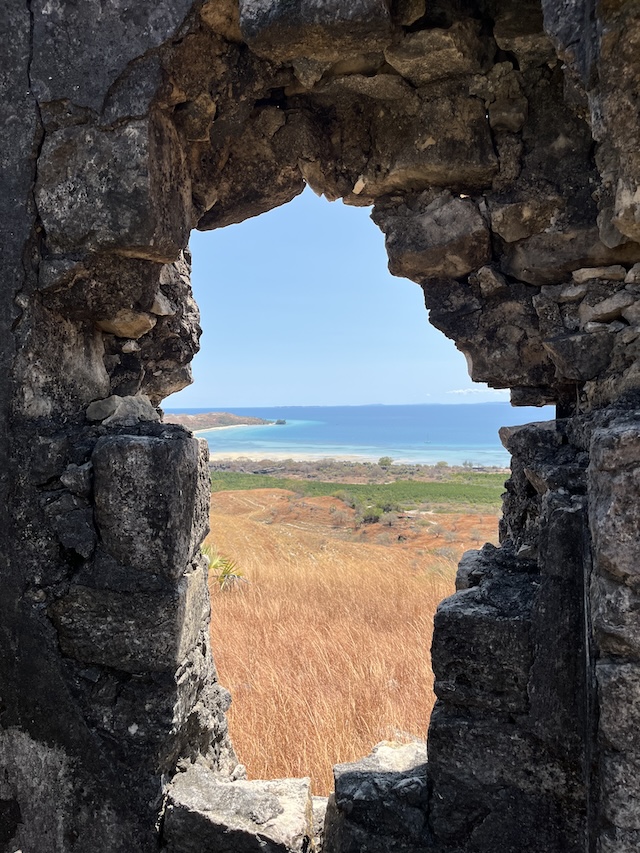

Recent burning throughout the stone structures suggests that the prison authority in Madagascar doesn’t want the ruins to become hopelessly overgrown. We understand from another yacht that there’s a prison guide somewhere on the island, but we couldn’t find him for a tour. A rumor has it that the guide is an ex-convict who was ordered to remain on the island to serve out his life sentence – even after the prison was closed. Unsubstantiated.
Day Hops Down the Coast
From Nosy Lava, we continued SW, making day hops down to beautiful Moramba Bay, a well protected and friendly bay complete with a couple new types of lemurs, entertaining hikes through the barren hills and lovely Brigitte, the daughter of a French father (from Grenoble!) and Malagasy mother.
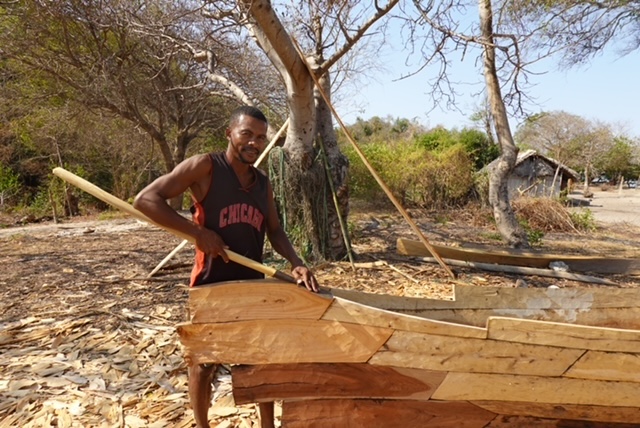

Brigitte has built a delightful estate on the beach for family and friends. She maintains quite a staff of workers maintaining and building out her elegant compound using local materials and craftsmanship. We spent several days in Moramba, each day watching the weather patterns near Cape Town for an opportunity to sail for South Africa.
Cindy scored some nice sunset pictures of the famous Malagasy Bau Bab trees. The iconic Bau Babs have a trunk like a pro footballer’s neck and a collection of thin spindly branches coming out the top. We assume they grow leaves in the wet season, but they are bare at this time of year.
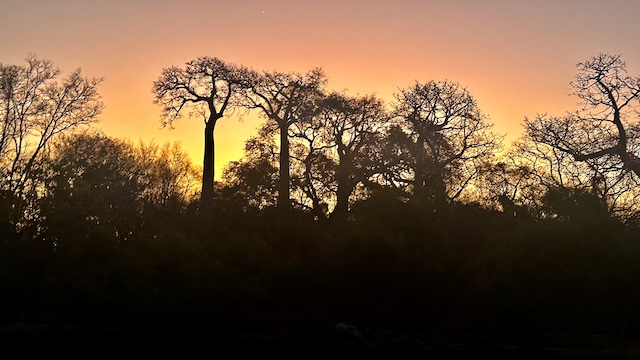

Anxious to keep moving, we continued our hopping along the SW coast, sailing by day when we could see the myriad fishing boats and shrimp pots and pulling over into the shallows at night to rest and wait for daylight. We weren’t in a hurry since weather to the south wasn’t inviting. We reached Baly Bay, our final departure point, on September 21. The raging southerly continued to blow out in the Mozambique channel so we enjoyed the quietude of the big, but shallow, Baly Bay.
Our anchorage bordered on a long beautiful and uninhabited beach. As we had already cleared out of Madagascar, we were reticent about visiting the local village, although it is very unlikely anyone would be interested in our visitor status. We took long walks on the beach and gave away some art supplies, clothing and some of our residual Malagasy ariary (cash) to local fishermen.
Every morning the fishing dhows (canoes and larger craft with large triangular sails supported by a stubby mast and long bamboo boom at the top) rode the night wind (offshore) to their fishing grounds. In the afternoons they all came flying home with the thermal sea breeze at their backs. These Malagasy fishermen are fine and hearty sailors, venturing out in conditions that have us reefed down and hanging on!
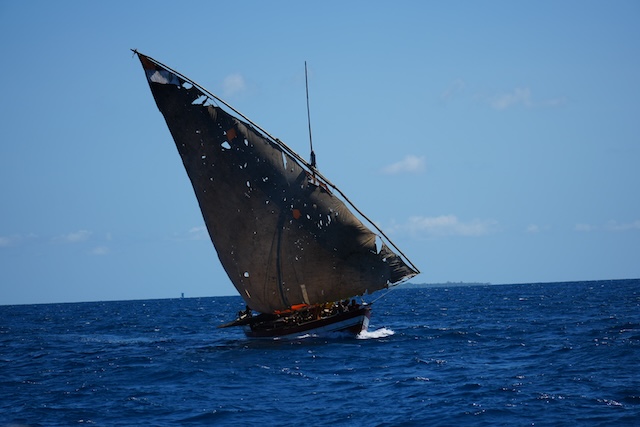

September 24 (2024) dawned bright and offered a fine east wind to carry us SW toward Cap St. Andre and out into the Mozambique channel, where the south winds and seas were abating. We waved vigorously to the smiling fishermen headed out to harvest their catch. The NW coast of Madagascar was a fun and interesting adventure. The wildlife (lemurs in particular) was a highlight, followed by delightful scenery and welcoming Malagasy people.
We’re blessed to experience this fascinating (and sometimes frustrating) country, but aren’t sad to move on to our next adventure through the Mozambique channel and South Africa.
Cheers
Anonymous.
………………………………
The opinions expressed in this article are the author’s own and do not reflect the view of Noonsite.com or World Cruising Club
.………………………………
Related Reports:
.………………………………
Find out all news, reports, links and comments posted on Noonsite, plus cruising information from around the world, by subscribing to our FREE monthly newsletter. Go to https://www.noonsite.com/newsletter/.
Related to following destinations: Ambodifototra (Ile Sainte Marie), Analalava, Antisiranana (Diego Suarez), Fort Dauphin (Taolagnaro), Madagascar, Mahajanga, Nossi-Be (Hell-Ville), Nosy Hara, Toamasina, Toleara
Related to the following Cruising Resources: Africa, Circumnavigation, Circumnavigation, Indian Ocean, Routing



